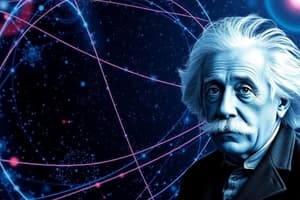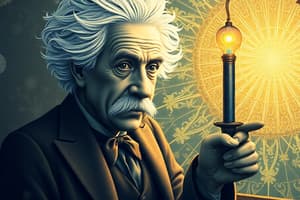Podcast
Questions and Answers
Astronomi modern menyarankan bahwa alam semesta berasal dari titik tunggal yang disebut sebagai?
Astronomi modern menyarankan bahwa alam semesta berasal dari titik tunggal yang disebut sebagai?
- Galaksi Andromeda
- Big Bang (correct)
- Bima Sakti
- Nebula Orion
Pada saat gerhana matahari total, satelit GPS memerlukan koreksi waktu berdasarkan efek perubahan ruang-waktu yang diprediksi oleh?
Pada saat gerhana matahari total, satelit GPS memerlukan koreksi waktu berdasarkan efek perubahan ruang-waktu yang diprediksi oleh?
- Perturbasi Bulan
- Gravitasi Benda Langit
- Warisan Einstein (correct)
- Teori Kuantum
Teori apa yang mengusulkan bahwa partikel fundamental mungkin tidak ada secara terpisah tetapi bergetar sepanjang lingkaran kecil?
Teori apa yang mengusulkan bahwa partikel fundamental mungkin tidak ada secara terpisah tetapi bergetar sepanjang lingkaran kecil?
- Teori Relativitas
- Teori Gravitasi
- Teori Quantum
- Teori String (correct)
Fisikawan modern terus mengeksplorasi berbagai frontier ilmu pengetahuan karena mereka mencari pengertian di luar?
Fisikawan modern terus mengeksplorasi berbagai frontier ilmu pengetahuan karena mereka mencari pengertian di luar?
Salah satu bukti eksperimental yang memperkuat teori relativitas Einstein adalah ketepatan laju presesi sistem tata surya dengan perhitungan dari?
Salah satu bukti eksperimental yang memperkuat teori relativitas Einstein adalah ketepatan laju presesi sistem tata surya dengan perhitungan dari?
Apa yang dikemukakan oleh Albert Einstein dalam teori relativitas khususnya?
Apa yang dikemukakan oleh Albert Einstein dalam teori relativitas khususnya?
Apa yang dimaksud dengan teori relativitas umum Albert Einstein?
Apa yang dimaksud dengan teori relativitas umum Albert Einstein?
Apa yang menjadi salah satu kontribusi signifikan teori relativitas umum Einstein?
Apa yang menjadi salah satu kontribusi signifikan teori relativitas umum Einstein?
Apa implikasi signifikan dari teori relativitas khusus terhadap peristiwa simultan?
Apa implikasi signifikan dari teori relativitas khusus terhadap peristiwa simultan?
Bagaimana Einstein menjelaskan gravitasi menurut teori relativitas umumnya?
Bagaimana Einstein menjelaskan gravitasi menurut teori relativitas umumnya?
Flashcards are hidden until you start studying
Study Notes
Modern Physics and Einstein's Relativity: Unraveling Space and Time
Modern physics is a vast tapestry of theories and discoveries that have transformed our understanding of the universe since the dawn of the 20th century. This exploration takes us through the revolutionary ideas of Albert Einstein's general theory of relativity—a cornerstone of contemporary physics. Let's delve into this fascinating realm where space and time intertwine like never before.
Special Theory of Relativity
Einstein introduced his special theory of relativity in 1905, laying the foundation upon which he would later build his groundbreaking general theory. In it, Einstein demonstrated that the speed of light in vacuum is constant regardless of how fast its source moves. Moreover, simultaneous events appear non-simultaneous when viewed from different frames of reference moving relative to each other. Time itself was revealed to be malleable.
General Theory of Relativity
In 1915, Continuing his quest to understand the intricate nature of reality, Einstein proposed a more comprehensive framework known as the general theory of relativity. It describes gravitation not as a force between masses, but rather as the curvature of spacetime caused by mass and energy. This theory explained several previously unexplained phenomena such as Mercury's orbit and bending of starlight near massive objects. Essentially, gravity becomes the warping of spacetime itself.
Cosmological Implications
One of the most consequential predictions of the general theory of relativity is the expansion of the universe. According to this model, the universe had a beginning, and everything within it originated from a single point called the Big Bang. While there remain many unanswered questions in cosmology, the theory of relativity forms a solid basis upon which scientists continue their exploration of the cosmos.
Experimental Evidence
The general theory of relativity has been confirmed numerous times over the past century using both laboratory experiments and astronomical observations. One famous example includes the solar system's precession rate being in perfect agreement with Einstein's calculations. Additionally, during total solar eclipses, GPS satellites require real-time corrections based on the predicted effects of the sun's warped spacetime. These tests demonstrate the accuracy and robustness of Einstein's theoretical insights.
Beyond Einstein's Reach
Despite its immense success, physicists continue to search beyond the confines of the standard model of particle physics and the theory of relativity. Quantum mechanics posits another set of indivisible particles and waves that govern behavior at the smallest scales. String theory suggests that fundamental particles may not exist separately but instead vibrate along tiny loops, yet this theory remains elusive.
These exciting frontiers remind us that while we appreciate what modern physics and Einstein's relativity have contributed thus far, the mysteries of the universe still await discovery.
Studying That Suits You
Use AI to generate personalized quizzes and flashcards to suit your learning preferences.




